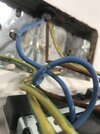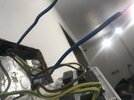One warning ... the exercise can become difficult and confusing if (as sometimes happens) the way in which the sockets have been wired does not correspond to what you would expect from the physical location of the sockets - since what you thought was 'the next socket along the ring' might not be!
What can sometimes help to determine the route of the ring, without disturbing anything, is by using a signal generator and tracer. Alternatively a very low Ohms resistance meter, connected between the earth pins of one socket and others in the area. Lowest resistance = two adjacent sockets on the ring.



